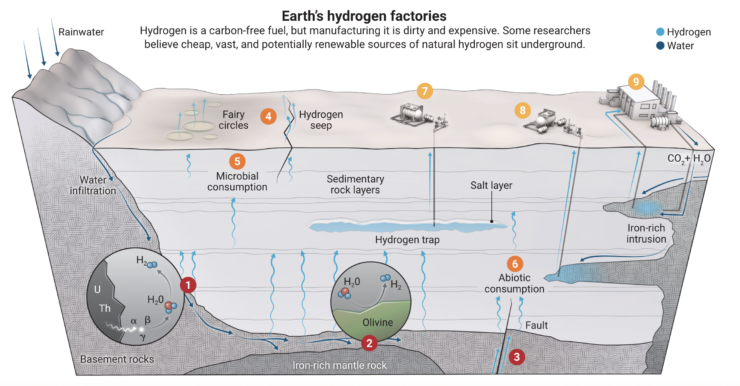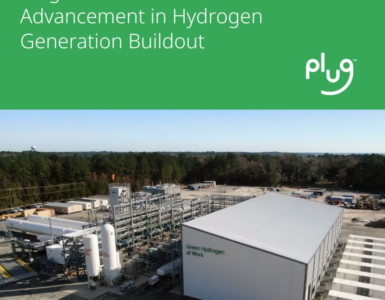HIDDEN HYDROGEN – Does Earth hold vast stores of a renewable, carbon-free fuel? – Science.
IN THE SHADE of a mango tree, Mamadou Ngulo Konaré recounted the legendary event of his childhood. In 1987, well diggers had come to his village of Bourakébougou, Mali, to drill for water, but had given up on one dry borehole at a depth of 108 meters.
Mamadou Ngulo Konaré said:
Meanwhile, wind was coming out of the hole.
Konaré told Denis Brière, a petrophysicist and vice president at Chapman Petroleum Engineering, in 2012. When one driller peered into the hole while smoking a cigarette, the wind exploded in his face.
🔥 What about we co-host a webinar? Let's educate, captivate, and convert the hydrogen economy!
Hydrogen Central is the global go-to online magazine for the hydrogen economy, we can help you host impactful webinars that become a global reference on your topic and are an evergreen source of leads. Click here to request more details
“He didn’t die, but he was burned,” Konaré continued. “And now we had a huge fire. The color of the fire in daytime was like blue sparkling water and did not have black smoke pollution. The color of the fire at night was like shining gold, and all over the fields we could see each other in the light. … We were very afraid that our village would be destroyed.”
It took the crew weeks to snuff out the fire and cap the well. And there it sat, shunned by the villagers, until 2007. That was when Aliou Diallo, a wealthy Malian businessman, politician, and chair of Petroma, an oil and gas company, acquired the rights to prospect in the region surrounding Bourakébougou.
Aliou Diallo, said:
We have a saying that human beings are made of dirt, but the devil is made of fire.
Diallo says. “It was a cursed place. I said, ‘Well, cursed places, I like to turn them into places of blessing.’”
In 2012, he recruited Chapman Petroleum to determine what was coming out of the borehole. Sheltered from the 50°C heat in a mobile lab, Brière and his technicians discovered that the gas was 98% hydrogen. That was extraordinary: Hydrogen almost never turns up in oil operations, and it wasn’t thought to exist within the Earth much at all. “We had celebrations with large mangos that day,” Brière says.
Within a few months, Brière’s team had installed a Ford engine tuned to burn hydrogen. Its exhaust was water. The engine was hooked up to a 30-kilowatt generator that gave Bourakébougou its first electrical benefits: freezers to make ice, lights for evening prayers at the mosque, and a flat-screen TV so the village chief could watch soccer games.
Children’s test scores also improved. “They had the lighting to learn their lessons before going to class in the morning,” Diallo says. He soon gave up on oil, changed the name of his company to Hydroma, and began drilling new wells to ascertain the size of the underground supply.
The Malian discovery was vivid evidence for what a small group of scientists, studying hints from seeps, mines, and abandoned wells, had been saying for years: Contrary to conventional wisdom, large stores of natural hydrogen may exist all over the world, like oil and gas—but not in the same places.
These researchers say water-rock reactions deep within the Earth continuously generate hydrogen, which percolates up through the crust and sometimes accumulates in underground traps. There might be enough natural hydrogen to meet burgeoning global demand for thousands of years, according to a U.S. Geological Survey (USGS) model that was presented in October 2022 at a meeting of the Geological Society of America.
“When I first heard about it, I thought it was crazy,” says Emily Yedinak, a materials scientist who devoted a fellowship at the Advanced Research Projects Agency-Energy (ARPA-E) to drumming up interest in natural hydrogen. “The more that I read, the more I started to realize, wow, the science behind how hydrogen is produced is sound … I was kind of like, ‘Why is no one talking about this?’”
Since 2018, however, when Diallo and his colleagues described the Malian field in the International Journal of Hydrogen Energy, the number of papers on natural hydrogen has exploded. “It’s absolutely incredible and really exponential,” says geologist Alain Prinzhofer, lead author on the Mali paper and scientific director of GEO4U, a Brazil-based oil and gas services company that is doing more and more hydrogen work.
Dozens of startups, many in Australia, are snatching up the rights to explore for hydrogen. Last year, the American Association of Petroleum Geologists formed its first natural hydrogen committee, and USGS began its first effort to identify promising hydrogen production zones in the United States.
Viacheslav Zgonnik, CEO of Natural Hydrogen Energy, said:
We’re in the very beginning, but it will go fast.
In 2019, the startup completed the first hydrogen borehole in the United States, in Nebraska.
READ the latest news shaping the hydrogen market at Hydrogen Central
HIDDEN HYDROGEN Does Earth hold vast stores of a renewable, carbon-free fuel?, February 16, 2023








